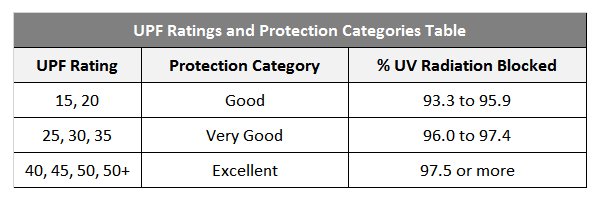Sun Protection Clothing And UV Protective Swimwear Factors And Warnings!
Posted by ecostinger on 19th Oct 2017
Most fabrics can provide some protection from the sun regardless of if they are UPF rated or not. However several factors will determine how effective clothing and swimwear is at reducing the UV reaching the skin. These factors include; the weave density; construction of the fabric; thickness; color; tension and stretch; additives added to fabric; and condition.
Fabric with UPF50+ ratings can block over 97.5% of the sun UV radiation as per Australian/New Zealand standard (AS/NZS 4399:1996), although this is the highest sun protection ratings, it can still be not enough when the UV index is high.
Never rely on clothing alone for sun protection when the UV index level is 3 and above; use a combination of
5 sun protection measures:
1. Apply sunscreen on exposed skin;
2. Cover up with UPF clothing;
3. Slap on a wide brim sun hat;
4. Wear EPF sunglasses;
5. Seek shade.
Recommendations for protection when the day’s predicted UV index is at various values are:
| UV Index | Description | Media Graphic Color | Recommended Protection |
| 0–2 | No danger to the average person | Green | No Protection Required Wear sunglasses on bright days; use sunscreen if there is snow on the ground, which reflects UV radiation, or if you have particularly fair skin. |
| 3–5 | Little risk of harm from unprotected sun exposure | Yellow | Protection Required Wear sunglasses and use sunscreen, cover the body with clothing and a hat, and seek shade around midday when the sun is most intense. |
| 6–7 | High risk of harm from unprotected sun exposure | Orange | Protection Required Wear sunglasses and use sunscreen having SPF 15 or higher, cover the body with sun protective clothing and a wide-brim hat, and reduce time in the sun from two hours before to three hours after solar noon (roughly 10:00 AM to 4:00 PM during summer in zones that observe daylight saving time). |
| 8–10 | Very high risk of harm from unprotected sun exposure | Red | Protection Required Wear sunscreen, a shirt, sunglasses, and a hat. Do not stay out in the sun for too long. |
| 11+ | Extreme risk of harm from unprotected sun exposure | Violet | Protection Required Take all precautions, including: wear sunglasses and use sunscreen, cover the body with a long-sleeve shirt and trousers, wear a very broad hat, and avoid the sun from two hours before to three hours after solar noon. |
Warnings!
Wet and stretched or over-stretched fabric may lower the rating of sun protection provided by clothing or swimwear; It is recommended to avoid spending long hours in the sun when the UV index level is 3 or more, and seek shade whenever possible to break the intensity of the sunlight, especially during midday solar noon; for more information visit ARPANSA website. below is UPF category table as set by Australia/New Zealand standard (AS/NZS 4399:1996).

Very Important!
Sun protection clothing, sun hats and sun protective swimwear ratings
are measured in UPF; do not be misled by the wrong rating term:
Ultraviolet protection factor (UPF) is a measure of the protection provided by clothing fabrics, the highest ratings is UPF50+ blocking over 97.5% of the sun UV rays, which will reduce the risk of sun damage drastically, however it is still important to seek shade during intense sunlight such as midday solar noon and avoiding over-stretched fabric.
Sun protection factor (SPF) is a measure of the protection provided by sunscreens.
Eye protection factor (EPF) is a measure of the protection provided by sunglasses and other eye wear.
Ultraviolet Protection Factor (UPF) is used to indicate the fraction of the UV rays from the sun that can penetrate a fabric. It represents the percentage of UV rays that can reach the skin with and without protection from clothing. For example, a long sleeved shirt that has a UPF of say 50 can only allow 1/50th UV radiation from the sun to the skin.
